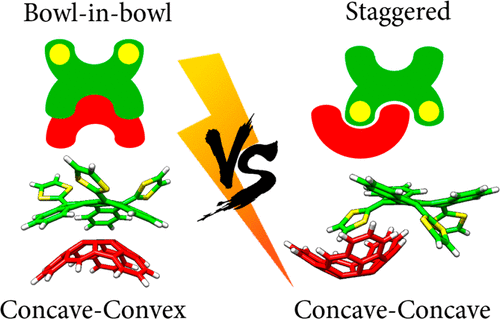当前位置:
X-MOL 学术
›
J. Phys. Chem. A
›
论文详情
Our official English website, www.x-mol.net, welcomes your feedback! (Note: you will need to create a separate account there.)
Bending Carbon Nanoforms for Supramolecular Recognition: A Topological Study on Hemifullerene-Based Aggregates
The Journal of Physical Chemistry A ( IF 2.9 ) Pub Date : 2018-01-17 00:00:00 , DOI: 10.1021/acs.jpca.7b11746 Joaquín Calbo 1 , Juan Aragó 1 , Roberto A. Boto 2 , José Sánchez-Marín 1 , Enrique Ortí 1 , Julia Contreras-García 3, 4
The Journal of Physical Chemistry A ( IF 2.9 ) Pub Date : 2018-01-17 00:00:00 , DOI: 10.1021/acs.jpca.7b11746 Joaquín Calbo 1 , Juan Aragó 1 , Roberto A. Boto 2 , José Sánchez-Marín 1 , Enrique Ortí 1 , Julia Contreras-García 3, 4
Affiliation

|
Buckybowls have risen as appealing fullerene fragment derivatives. Their intrinsic curvature has been exploited in the generation of host–guest supramolecular assemblies, not only through concave–convex complementarity but also through less-known concave–concave staggered arrangements. Whereas the stabilization of bowl-in-bowl dispositions has been ascribed to efficient π–π forces together with favorable dipole–dipole interactions, a detailed analysis on the forces guiding the formation of the staggered arrangements is missing so far. Herein, we present a thorough theoretical characterization of bowl-in-bowl vs staggered hemifullerene-based homodimers and heterodimers with the electron-donor truxTTF molecule, as test cases, under the density functional theory and by means of chemical bonding techniques. Our results clearly reveal strong and localized noncovalent signatures, together with an enhanced orbital interaction, associated with CH−π and sulfur-mediated interactions governing the staggered formation. Bending the fullerene fragment is demonstrated to favor the stabilization in both homo- and heterodimers, in good accord with the depletion in the π-electron density calculated upon increasing the buckybowl curvature. The optimal buckybowl curvature for the highest interaction energy is, however, dependent on the type of supramolecular assembly (bowl-in-bowl vs staggered) and the concave region to which hemifullerene approaches truxTTF. Interestingly, two regimes are found as a function of buckybowl curvature for hemifullerene homodimers: bowl-in-bowl dispositions are calculated more stable at low curvatures whereas staggered dimers prevail for highly curved buckybowls. Our results highlight the potential of discrete CH−π and sulfur-mediated interactions to generate unconventional staggered supramolecular arrangements toward the development of a new and unexplored host–guest chemistry.
中文翻译:

用于超分子识别的弯曲碳纳米形态:基于半富勒烯的聚集体的拓扑研究
Buckybowls已经成为富有吸引力的富勒烯片段衍生物。它们的固有曲率已在宿主-客体超分子组装的产生中得到利用,不仅通过凹凸互补,而且通过鲜为人知的凹凸交错排列。尽管碗中碗配置的稳定归因于有效的π-π力以及有利的偶极-偶极相互作用,但到目前为止,对引导交错结构形成的力的详细分析尚缺乏。在本文中,我们在密度泛函理论和化学键合技术的基础上,对电子供体truxTTF分子与碗状碗与交错的基于半富勒烯的均二聚体和异二聚体进行了全面的理论表征。我们的结果清楚地揭示了强大且局部的非共价标记,以及增强的轨道相互作用,与支配交错形成的CH-π和硫介导的相互作用有关。已证明弯曲富勒烯片段有利于均二聚体和异二聚体中的稳定化,这与通过增加巴基鲍尔曲率而计算出的π电子密度的损耗良好地一致。然而,具有最高相互作用能的最佳buckybowl曲率取决于超分子组装体的类型(碗中碗与交错碗)和半富勒烯接近truxTTF的凹入区域。有趣的是,对于半富勒烯同型二聚体,发现了两种方案与巴克鲍尔曲率的关系:计算得出,在低曲率下,碗中碗的布置更加稳定,而对于高度弯曲的巴克杯,交错二聚体占优势。我们的结果表明,离散的CH-π和硫介导的相互作用可能会产生非常规的交错超分子排列,从而发展出一种新的,尚未开发的宿主—客体化学。
更新日期:2018-01-17
中文翻译:

用于超分子识别的弯曲碳纳米形态:基于半富勒烯的聚集体的拓扑研究
Buckybowls已经成为富有吸引力的富勒烯片段衍生物。它们的固有曲率已在宿主-客体超分子组装的产生中得到利用,不仅通过凹凸互补,而且通过鲜为人知的凹凸交错排列。尽管碗中碗配置的稳定归因于有效的π-π力以及有利的偶极-偶极相互作用,但到目前为止,对引导交错结构形成的力的详细分析尚缺乏。在本文中,我们在密度泛函理论和化学键合技术的基础上,对电子供体truxTTF分子与碗状碗与交错的基于半富勒烯的均二聚体和异二聚体进行了全面的理论表征。我们的结果清楚地揭示了强大且局部的非共价标记,以及增强的轨道相互作用,与支配交错形成的CH-π和硫介导的相互作用有关。已证明弯曲富勒烯片段有利于均二聚体和异二聚体中的稳定化,这与通过增加巴基鲍尔曲率而计算出的π电子密度的损耗良好地一致。然而,具有最高相互作用能的最佳buckybowl曲率取决于超分子组装体的类型(碗中碗与交错碗)和半富勒烯接近truxTTF的凹入区域。有趣的是,对于半富勒烯同型二聚体,发现了两种方案与巴克鲍尔曲率的关系:计算得出,在低曲率下,碗中碗的布置更加稳定,而对于高度弯曲的巴克杯,交错二聚体占优势。我们的结果表明,离散的CH-π和硫介导的相互作用可能会产生非常规的交错超分子排列,从而发展出一种新的,尚未开发的宿主—客体化学。



























 京公网安备 11010802027423号
京公网安备 11010802027423号